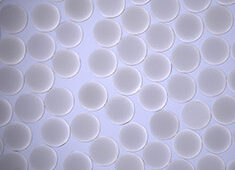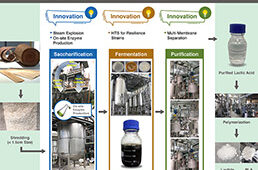An alternative to precious metal: Max Planck scientists used this crystal of an iron-aluminum compound to catalyze an important step in the production of polyethylene plastic. To date, industry has used a palladium compound for this process. Image: MPI for Chemical Physics of Solids |
Chemists don’t like precious metals—at least not when they
need the expensive materials as catalysts to accelerate reactions or guide them
in a particular direction. And this is often the case, as in an important step
in the production of polyethylene, a substance that makes plastic bags light,
flexible, and stable. However, a team of scientists from the Max Planck
Institute for Chemical Physics of Solids in Dresden and the Fritz Haber
Institute of the Max Planck Society in Berlin have now developed a catalyst
using iron and aluminum that works just as well as the conventional palladium
catalyst, but costs much less. To identify the iron-aluminum alternative, the
scientists first systematically ascertained what properties the material would
need. They plan to use this same procedure to search for catalysts for other
reactions in future.
Were
it not for the fact that the chemical industry routinely uses palladium as a
reagent for polyethylene, plastic bags would be a great nuisance, ripping when
loaded with just a couple of apples and a carton of milk. However, we are
spared this fate by the reliable work of the precious metal. Palladium converts
ethine, more commonly known as acetylene, into ethene, also known as ethylene,
which is used to make polyethylene. Ethylene always contains traces of
acetylene, because both substances are obtained from crude oil and are not
easily separated. However, acetylene interferes in the conversion of ethylene
to polyethylene. Therefore, unless it is first converted to ethylene by the
attachment of two hydrogen atoms in the presence of palladium, the resulting
plastic is of poor quality.
Worldwide
production of polyethylene amounts to 80 million tons each year, thus the costs
of acetylene conversion add up to a considerable sum. However, these costs
could drop significantly, as it may now be possible for industry to manage
without the palladium catalyst, using an intermetallic compound of iron and aluminum
instead. Working with the Ludwig Maximilians Universität Munich and
Forschungszentrum Jülich, scientists from Dresden’s
Max Planck Institute for Chemical Physics of Solids and the Fritz Haber
Institute of the Max Planck Society in Berlin
have identified this material as an effective substitute for palladium, finding
that it hydrogenates acetylene to ethylene just as efficiently as
precious-metal catalysts.
“It
was not by trial and error that we discovered that this compound is so
suitable, but by a knowledge-based approach”, says Marc Armbrüster of the
Dresden-based Max Planck Institute. Knowledge-based means that the scientists
used their knowledge of precisely how the reaction at the palladium catalyst
occurs. They then deduced the critical aspects and searched for a suitable
material with these criteria in mind.
Their
first lead was the well-known fact that even palladium only delivers the
desired results when it is present at the smallest possible active sites, as
individual palladium atoms on an inactive silver matrix; otherwise the
acetylene reaction does not stop at semi-hydrogenation. In this case, acetylene
takes not two, but four hydrogen atoms and is converted to ethane, which is
quite unsuitable for the chain reaction leading to polyethylene. “It seems
that the acetylene molecules attach themselves to the tiny palladium sites in
such a way that they can only selectively take up two hydrogen atoms”,
explains Marc Armbrüster. However, finely distributed palladium in a silver
alloy gradually clumps into larger aggregates under the reaction conditions,
and its selectivity becomes increasingly compromised.
As
they discussed this in 2004, Juri Grin, Director at the Max Planck Institute
for Chemical Physics of Solids, and Robert Schlögl, Director at the Fritz Haber
Institute of the Max Planck Society in Berlin,
came up with the idea of fixing the active sites, the individual palladium
atoms, in a crystal lattice. As a result, the following years saw them pool the
core competencies of two Max Planck Institutes—for catalysis in Berlin and for intermetallic compounds in Dresden—to solve an
important practical problem. This cooperation yielded immediate results, as the
search for a suitable catalyst for the semi-hydrogenation of acetylene quickly
revealed a gallium-palladium compound as the material of choice.
The
fact that this is an intermetallic compound and not an alloy is decisive,
partly because the metals do not mix haphazardly (as alloys do), but form
highly ordered crystal structures. As a result, the atomic structure of an
intermetallic compound differs from that of its components in their pure forms.
In the case of the palladium-gallium compound, every palladium atom in the
crystal structure is surrounded exclusively by catalytically inactive gallium
atoms. This means that the individual catalytic sites are kept strictly
separate from each other.
The
success of the basic idea encouraged the scientists to take the next step and
search for a material that would exhibit catalytic properties like those of the
palladium-gallium compound, but without the palladium. It was the crystal
structure of the Al13Fe4 compound that caught their
attention, as its aluminum atoms keep the iron atoms apart in exactly the same
way that the gallium atoms separate the palladium atoms in the
palladium-gallium catalyst.
However,
this alone would not be enough to ensure a workable catalyst for acetylene
conversion; the candidate compound would only be suitable if it converted
acetylene molecules in the same way as the palladium catalyst. This question in
turn depends largely on the distribution of electrons in the material, their
energy and how they influence the binding of acetylene molecules. The aluminum-iron
and palladium-gallium compounds are similar to one another in these aspects,
and the iron-aluminum compound actually does deliver precisely two hydrogen
atoms to the acetylene molecules just as reliably as the palladium-gallium
catalyst.
Before
the new catalyst can be used to reduce the costs of polyethylene production, it
must prove itself in industrial scale applications. If it passes that test, it
could prove its value as a selective hydrogen catalyst in the production of
other synthetic materials.
Meanwhile,
the Dresden- and Berlin-based chemists want to systematically search for
catalysts for other reactions. One important finding of their work is that the
knowledge-based approach can spell success in catalysis research, and perhaps
one day mean that the chemical industry can manage without any precious metals
in its reactors. Many everyday products could then be cheaper—and that would be
good news for more than just chemists.
Source: Max-Planck Gesellschaft





